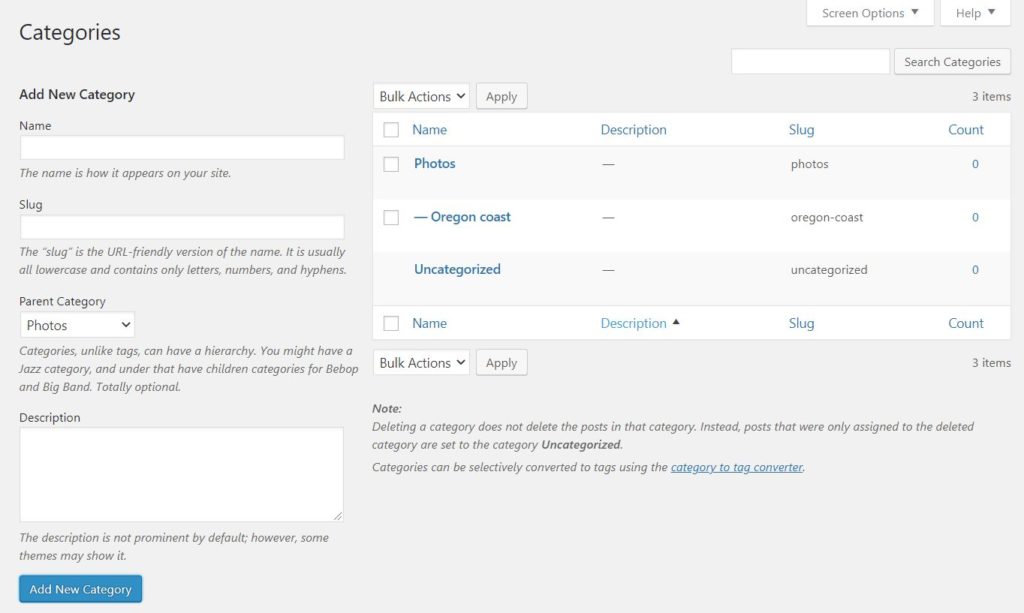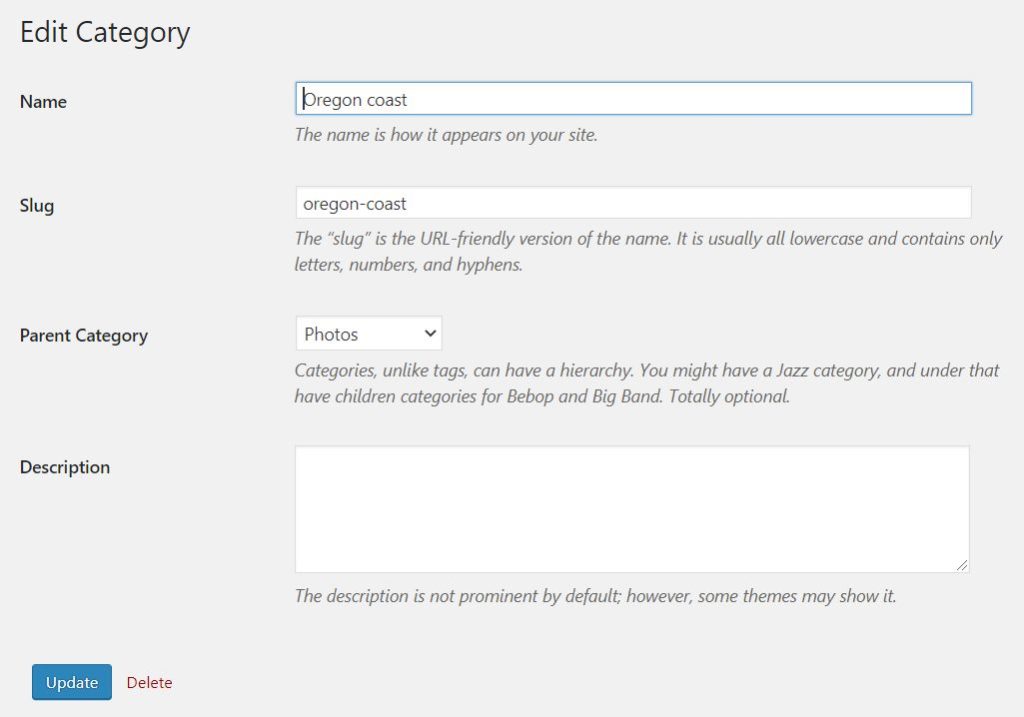Each post in ClassicPress is filed under one or more categories. This aids in navigation and allows posts to be grouped with others of similar content.
Posts not assigned a category will be given the Default Post Category that is specified in the Writing Settings.
Each category may be assigned to a Category Parent, allowing you to set up a hierarchy within the category structure.
In creating categories, be aware that each category name must be unique. So, even if two categories have two different parents, they must still have different names.
Links to your categories might be shown in various places on your site, depending on your chosen theme and setup. For example, they could be listed as links in your sidebar. They may also appear in an individual post to show the other related posts available in that same category. When someone clicks on one of these category links, an archive page with all the posts belonging to that category will be displayed.
Category ScreenLink to this section
The Category Screen allows you to create new categories, edit or delete existing ones, and organize your categories hierarchically.

This screen is divided into the two sections – Add New Category on the left, and the Category Table on the right.
Add New CategoryLink to this section
This part of the screen allows you to create a new category. There are four pieces of information associated with each new category: the name, slug, category parent, and description.
Name: To reiterate, the category name must be unique.
Slug: The category slug must be unique. The category slug is used in the URL. For example, setting a category name of “Recipes” and a category slug of “food” would show all “Recipes” posts with a URL like example.com/blog/food/.
Parent: Use this drop-down if you want to make this category a sub-category; you will select the sub-category’s parent here. For example, you may have a category called “Photos” but want to add further clarification about the subject of a particular “Photos” post. You could add “Oregon coast” and “Ice storm” as sub-categories to the “Photos” category; “Photos” would be the parent of these two new sub-categories.
Sub-categories show up on your blog’s page just like categories, except they will typically be nested under their parent categories. When someone visits your site and clicks the “Photos” category link, all posts in “Photos” and all its sub-categories will be displayed. Clicking the “Oregon coast” category link only displays those post in that sub-category. If you assign a post to a sub-category (e.g. “Oregon coast”), you can choose to assign that post to the sub-category’s parent (“Photos”) or not. Either way, all “Oregon coast” posts will show up in the “Photos” category page. The only difference is in the list of categories to which a particular post belongs.
Please note that when creating templates, you cannot match a child category based on the parent (ie: if category “bar” has parent “foo”, a template file named “category-foo.php” will not match any “bar” category posts.)
Description: Category descriptions are optional. Some themes take advantage of category descriptions, others do not, so having descriptions may or may not modify the way categories are displayed for your site. Even if they are not used by your site’s theme, you may still find them useful from an administration point of view.
Add New Category: Once you’ve entered in all the information about your new category, use this button to save it.
Category TableLink to this section
This table lists all of your categories by row. Categories are displayed hierarchically and alphabetically; subcategories are displayed beneath their parents and are prefaced by long dashes. These dashes are not part of a category’s name; they are there only to show hierarchy.
The table of categories contains the following columns:
[ ] – A checkbox that when clicked (checked), ‘selects’ that particular category to be deleted when the delete action is applied.
Name – The name of the category (each name must be unique).
Description – Categories may have an optional description. By default, the description is shown to viewers when they hover over the category’s link.
Slug – The slug of a category (usually in lower case letters).
Posts – The number of posts which are members of the category. Click on the number in the posts column to be directed to the All Posts screen to manage the posts in that category.
Screen OptionsLink to this section
The Screen Options allow you to choose which columns are displayed, or not displayed, in the underlying table. Clicking on the screen options tab shows a list of the columns with a check-box next to each column. Check the box for each column you want displayed in the table, or uncheck the box to not display that column. In addition, the number of categories to display in the table of categories can be set. Click Apply to save the options and close the screen.
SearchLink to this section
Above the table, to the right, is a search box where you can enter a word, or series of words, and click the “Search Categories” button to search and display all the categories meeting your search words.
Using Selection, Actions, and ApplyLink to this section
SelectionLink to this section
This section allows Actions to be performed on one or more categories displayed in the table. For actions to be performed on multiple categories at once, those categories must be first selected via one of these methods:
Select one category at a time – to select a category, the checkbox to the left of the category entry can be checked (clicked). It is possible to select multiple categories by checking their respective checkboxes.
Select all categories in given table – all categories in a given table can be selected by checking the checkbox in the table’s title, or footer bar. Of course, unchecking the header or footer title bar checkbox will cause all entries in that table to be unchecked (NOT selected).
Reverse Selection – A reverse selection means checked items become unchecked, and unchecked items become checked. A reverse selection is accomplished by holding the Shift key on the keyboard and clicking the header or footer title bar checkbox.
ActionsLink to this section
Actions describe the process to be performed on particular categories. There are two styles of actions that will be referred to as Bulk Actions and Immediate Actions. The follow describes these actions:
Bulk Actions – These actions can be performed on one, or more categories, at one time, if those categories have been previously selected. Bulk actions are available, when appropriate, as choices in the actions pull-down box, above each table. The only bulk action allowed here is delete.
Immediate Actions – Immediate actions are performed immediately, on an individual category. Hovering the mouse cursor over the category row reveals the Edit, Quick Edit, Delete and View options under the name column in that category row. Clicking on a category name will also initiate the Edit action.
The available actions are described below:
Edit – This immediate action displays the Edit Category Screen to edit the category fields. This action can be initiated by click on the category name or clicking on the edit option just below the category name.
Quick Edit – This immediate action initiates the quick edit of that category.
Delete – This action deletes the category. Delete is available as a both a bulk action and an immediate action. Note: Deleting a category does not delete the posts in that category, but the posts that were assigned to the deleted category are assigned to the Default Post Category, as defined in the Writing Settings screen. Note that the default category cannot be deleted.
View – This immediate action, if supported by the active theme’s template, will display the posts belonging to the category.
ApplyLink to this section
After one or more categories are selected, and after a bulk action is specified, the apply button performs the given action on the selected categories.
Quick EditLink to this section
The following fields can be change via the Quick Edit action:
Category Name: To reiterate, the category name must be unique.
Category Slug: Again, the category slug must be unique.
Cancel: Click this button to cancel any changes and return to the table of categories
Update Category: Once you’ve edited all the information about the category, use this button to save the changes.
Edit CategoryLink to this section
This screen is displayed by clicking on a category’s name in the table of categories, or by clicking on the edit option just below the category name. It is possible to edit four pieces of information associated with each category: the name, the slug, the parent, and the description.

Category Name and Category Slug: Category name and category slug must be unique.
Category Parent: Use this drop-down if you want to make this category a sub-category; you will select the sub-category’s parent here. For example, you may have a category called “Photos” but want to add further clarification about the subject of a particular “Photos” post. You could add “Oregon coast” and “Ice storm” as sub-categories to the “Photos” category; “Photos” would be the parent of these two new sub-categories.
Description: Category descriptions are optional. Some themes take advantage of category descriptions, others do not, so having descriptions may or may not modify the way categories are displayed for your site.
Update: Once you’ve changed the category information, use this button to save the changes.
